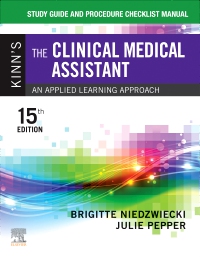
Study Guide and Procedure Checklist Manual for Kinn's The Clinical Medical Assistant - Elsevier eBook on VitalSource, 15th Edition
Elsevier eBook on VitalSource

Designed to support the trusted content in Kinn’s The Clinical Medical Assistant, 15th Edition, this study guide is an essential review and practice companion to reinforce key concepts, encourage critical thinking, and help students apply medical assisting content. This robust companion guide offers a wide range of activities to reinforce students’ understanding of common clinical skills — including certification preparation questions, a review of medical terminology and anatomy, and application exercises. Trusted for more than 65 years as a key part of the student journey from classroom to career, it also features competency checklists and clearly defined rubrics to accurately measure your students’ performance from day one through graduation.
-
- NEW! Content aligns to 2022 medical assisting educational competencies
- NEW! Advanced Clinical Skills unit features three new chapters on IV therapy, radiology basics, and radiology positioning to support expanded medical assisting functions
- NEW! Coverage of telemedicine, enhanced infection control related to COVID-19, and catheterization
- NEW! Procedures address IV therapy, limited-scope radiography, applying a sling, and coaching for stool collection
- EXPANDED! Information on physical medicine and rehabilitation
- EXPANDED! Content on specimen collection, including wound swab, nasal, and nasopharyngeal collections
- Comprehensive coverage of all clinical procedures complies with accreditation requirements
- Approximately 135 step-by-step procedure checklists enable students to assess and track their performance for every procedure included in the textbook
- Chapter-by-chapter correlation with the textbook allows students to easily follow core textbook competencies
- Matching and acronym activities reinforce understanding of medical terminology, anatomy and physiology, and chapter vocabulary
- Short-answer and fill-in-the-blank exercises strengthen student comprehension of key concepts
- Multiple-choice questions help students prepare for classroom and board exams
- Workplace application exercises promote critical thinking and job readiness before students enter practice
- Internet exercises offer ideas for expanded and project-based learning
-
- NEW! Content aligns to 2022 medical assisting educational competencies
- NEW! Advanced Clinical Skills unit features three new chapters on IV therapy, radiology basics, and radiology positioning to support expanded medical assisting functions
- NEW! Coverage of telemedicine, enhanced infection control related to COVID-19, and catheterization
- NEW! Procedures address IV therapy, limited-scope radiography, applying a sling, and coaching for stool collection
- EXPANDED! Information on physical medicine and rehabilitation
- EXPANDED! Content on specimen collection, including wound swab, nasal, and nasopharyngeal collections
-
1. The Professional Medical Assistant and the Healthcare Team
2. Health Records
3. Introduction to Medical Terminology and Anatomy
4. Infection Control
5. Vital Signs
6. Physical Examination
7. Patient Coaching
8. Nutrition and Health Promotion
9. Surgical Supplies and Instruments
10. Assisting with Surgical Procedures
11. Principles of Electrocardiography
12. Medical Emergencies
13. Principles of Pharmacology
14. Pharmacology Math
15. Administering Medications
16. Ophthalmology and Otolaryngology
17. Dermatology
18. Allergy and Infectious Disease
19. Gastroenterology
20. Orthopedics and Rheumatology
21. Physical Medicine and Rehabilitation
22. Neurology
23. Behavioral Health
24. Endocrinology
25. Cardiology
26. Pulmonology
27. Urology and Male Reproduction
28. Obstetrics and Gynecology
29. Pediatrics
30. Geriatrics
31. Introduction to the Clinical Laboratory
32. Urinalysis
33. Blood Collection
34. Analysis of Blood
35. Microbiology and Immunology
36. Intravenous Therapy
37. Radiology Basics
38. Positioning for Radiology
39. Skills and Strategies




 as described in our
as described in our 